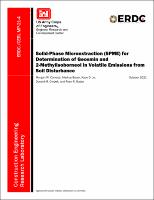Please use this identifier to cite or link to this item:
https://hdl.handle.net/11681/42289| Title: | Solid-phase microextraction (SPME) for determination of geosmin and 2-methylisoborneol in volatile emissions from soil disturbance |
| Authors: | Conrady, Morgan W. Jo, Kyoo D. Cropek, Donald M. (Donald Michael) Busby, Ryan R. Bauer, Markus |
| Keywords: | Solid-phase microextraction Gas chromatograph mass spectrometer (GC-MS) Geosmin 2-methylisoborneol Volatile organic compounds |
| Publisher: | Construction Engineering Research Laboratory (U.S.) Engineer Research and Development Center (U.S.) |
| Series/Report no.: | Miscellaneous Paper (Engineer Research and Development Center (U.S.)) ; no. ERDC/CERL MP-21-4 |
| Is Version Of: | Conrady, Morgan W., Markus Bauer, Kyoo D. Jo, Donald M. Cropek, and Ryan R. Busby. "Solid-phase microextraction (SPME) for determination of geosmin and 2-methylisoborneol in volatile emissions from soil disturbance." Chemosphere 284 (2021): 131333. https://doi.org/10.1016/j.chemosphere.2021.131333 |
| Abstract: | A method is described here for the concentration and determination of geosmin and 2-methylisoborneol (2-MIB) from the gaseous phase, with translation to field collection and quantification from soil disturbances in situ. The method is based on the use of solid-phase microextraction (SPME) fibers for adsorption of volatile chemicals from the vapor phase, followed by desorption into a gas chromatograph-mass spectrometer (GC-MS) for analysis. The use of a SPME fiber allows simple introduction to the GC-MS without further sample preparation. Several fiber sorbent types were studied and the 50/30 μm DVB/CAR/PDMS was the best performer to maximize the detected peak areas of both analytes combined. Factors such as extraction temperature and time along with desorption temperature and time were explored with respect to analyte recovery. An extraction temperature of 30 ◦C for 10 min, with a desorption temperature of 230 ◦C for 4 min was best for the simultaneous analysis of both geosmin and 2-MIB without complete loss of either one. The developed method was used successfully to measure geosmin and 2-MIB emission from just above disturbed and undisturbed soils, indicating that this method detects both compounds readily from atmospheric samples. Both geosmin and 2-MIB were present as background concentrations in the open air, while disturbed soils emitted much higher concentrations of both compounds. Surprisingly, 2-MIB was always detected at higher concentrations than geosmin, indicating that a focus on its detection may be more useful for soil emission monitoring and more sensitive to low levels of soil disturbance. |
| Description: | Miscellaneous Paper |
| Gov't Doc #: | ERDC/CERL MP-21-4 |
| Rights: | Approved for Public Release; Distribution is Unlimited |
| URI: | https://hdl.handle.net/11681/42289 http://dx.doi.org/10.21079/11681/42289 |
| Appears in Collections: | Miscellaneous Paper |
Files in This Item:
| File | Description | Size | Format | |
|---|---|---|---|---|
| ERDC-CERL MP-21-4.pdf | 1.07 MB | Adobe PDF |  View/Open |